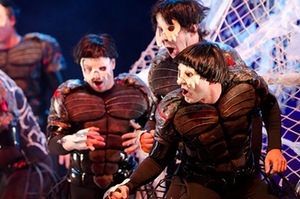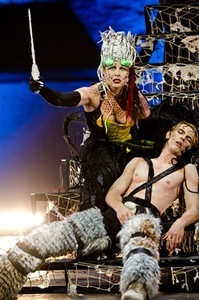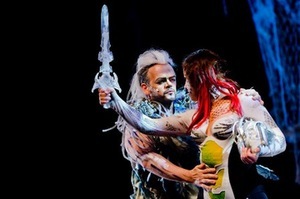HORROR DRAMA AT KAUNAS STATE MUSICAL THEATRE: G. VERDI'S 'ATTILA' 0
In brief: Kaunas State Musical Theatre presented a premiere again – G. Verdi‘s ‘Attila’ was introduced to audience on the 25th of November. This masterpiece was staged in Lithuania for the first time. ‘Attila’ is the joint production of Kaunas State Musical Theatre, Estonian non-commercial organisation PromFest and Pärnu City Endla Theatre.
The fact that the performance originally was born in Pärnu determined the choice of the interpreters of the opera. Nearly all the authors are Estonian artists: the performance was directed by Üllar Saaremäe, choreography was created by Oleg Titov, lights – by Margus Vaigur, costumes and scenography – by Madis Nurms. Lithuania was represented by the choirmasters Ramūnas Tilvikas and Rasa Vaitkevičiūtė and the conductor Virgilijus Visockis. The latter shared the baton together with the Estonian colleague Erki Pehku. The international company could be seen on stage too: Lithuanians Tadas Girininkas, Evaldas Kondrackis, Sandra Janušaitė, Ričardas Karalevičius and guests – Erik Fenton (USA) and Vladislav Sulimsky (Belarus).
The performance was unusual to Kaunas State Musical Theatre not only because of its international background. The choice of the work was also interesting – G. Verdi’s ‘Attila’ was based upon F. L. Zacharias Werner’s tragedy ‘Attila, King of the Huns’. The performance was announced as ‘one of the best opera scores of G. Verdi that includes an impressive fabric of music, a striking scenic spectacle – fights, battles, fire, solemn ceremonies and a horrifying subject of the bride killing her groom’. The music of the opera is impressive indeed but its subject and idea reminds of the musical culture of the rational France in the 19th c. rather than the melodious Italy.
G. Verdi himself most probably was interested in the structure, harmony and mass scenes rather than an intimate topic of unhappy love. Maybe it was the reason why the opera lacked popularity – it used to be staged rarely compared to other operas.
The aspect of the Estonian interpretation was the most important while watching the opera at Kaunas State Musical Theatre. The costumes raised some controversy: at first glance they looked uncanny and exciting but later their hyperbolized ferity started to annoy. The greasepaint seemed to be too sharp and a sham set, instead of being scary, suggested that the Hun Attila and his people had lived in an awful mess and eternal darkness.
The direction of the performance was also different from the Lithuanian one. The performance returned to the old interpretation of the genre, when soloists used to stand and sing only, barely moving on stage. The soloists tried to express their emotions by miming but it looked wild and angry in a caricatural way. The choreography evoked a similar impression by eventually turning boring during the performance.
The shaping of the opera was rather disappointing but the soloists represented a warm, professional and distinctive aspect of the performance. Sandra Janušaitė was especially fascinating; she remained feminine – militant but gentle. The guest from the USA Erik Fenton appeared nicely in lyric scenes; he might have lacked militancy in certain scenes but people usually are moved by sensitivity, not brutality. The guest from Belarus Vladislav Sulimsky was soldierly and strong and the performer of the main role Tadas Girininkas (Attila) showed no soft feelings or emotions – just like you would imagine the cruel leader of the Huns.
Only time will prove the popularity of this performance. G. Verdi once said: ‘I write music to people, not critics’. So let this opera be evaluated not only by critics but also viewers.











